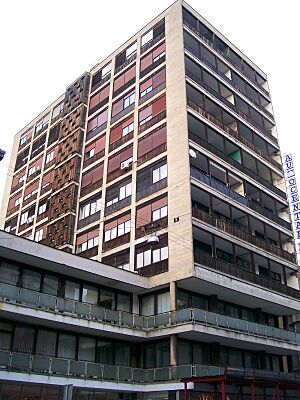Drago Ibler facts for kids
Quick facts for kids
Drago Ibler
|
|
|---|---|
| Born | 14 August 1894 |
| Died | 12 September 1964 (aged 70) |
| Nationality | Croatian |
| Occupation | Architect |
| Buildings |
|
Drago Ibler (born August 14, 1894 – died September 12, 1964) was an important Croatian architect and teacher. He was known for his simple and practical building designs. This style is often called functional architecture.
Contents
Early Life and Education
Drago Ibler was born in Zagreb, which is now the capital of Croatia. He studied architecture in Dresden, Germany. He earned his diploma there.
In 1921, Ibler joined a group of artists and architects in Paris. This group was led by the famous architect Le Corbusier. From 1922 to 1924, Ibler continued his studies in Berlin, Germany. He learned from a German architect named Hans Poelzig. Poelzig's ideas greatly influenced Ibler's early work.
Modern Architecture in Yugoslavia
Ibler's first big project was the District Labour Insurance Building in Zagreb. He designed it in 1923. This building was very important. It was the first project in Yugoslavia to show the new ideas of modern architecture.
Between 1925 and 1935, Ibler helped start the "Zagreb school of architecture." He worked with other architects like Drago Galić and Stjepan Planić. This group helped shape modern building design in the region.
Social Ideas and Artistic Groups
Drago Ibler believed that modern architecture should also help society. He thought buildings should be useful and beautiful. He co-founded the Earth Group (Croatian: Grupa Zemlja). This was a group of artists who wanted to use art to promote social change.
He was also a member of CIAM. This was an international group of architects. They worked together to develop and spread modern architectural ideas around the world.
Key Buildings and Designs
In the 1920s and 1930s, Ibler entered many design competitions. However, his ideas were often too new for the time. People were not ready for his modern designs.
During this period, he designed several villas. These were private homes on the island of Korčula and in Zagreb. He also designed some industrial buildings.
One important project was the District Labour Insurance Building in Mostar. It was built in 1930. Today, it is a health clinic. This building has a unique curved entrance. It also balances different parts of the building in a dynamic way.
Later, he designed the District Labour Insurance Building in Skopje in 1932. This building was very important for architecture in Yugoslavia. It used ideas from Le Corbusier, like long, horizontal "ribbon windows."

Teaching Career
In 1926, Drago Ibler became a professor. He taught architecture at the University of Zagreb Academy of Fine Arts. He taught there until 1941. After that, he moved to Switzerland. He became a lecturer in architecture at the University of Geneva.
Later Work and Influence
After World War II, Ibler returned to Zagreb in 1950. He continued teaching at the Academy of Fine Arts. He also led a special Master Studio for architecture students.
In his later years, Ibler's style changed. He moved away from strict functionalism. He started to make buildings more decorative and artistic. He wanted architecture to feel more human and harmonious.
Some of his designs from this time were never built. These include plans for a New Opera House in Belgrade (1948). He also designed a New Yugoslav Embassy in Moscow (1959). Another unbuilt project was a New Tito's Residence in Zagreb (1961-1964).
Before he passed away, Ibler designed several apartment buildings in central Zagreb. These buildings are known for their simple and practical layouts. You can find them on Martićeva, Smičiklasova, and Vlaška Streets.
Death
Drago Ibler died at the age of 70. He was in a car accident near Novo Mesto, Slovenia.

